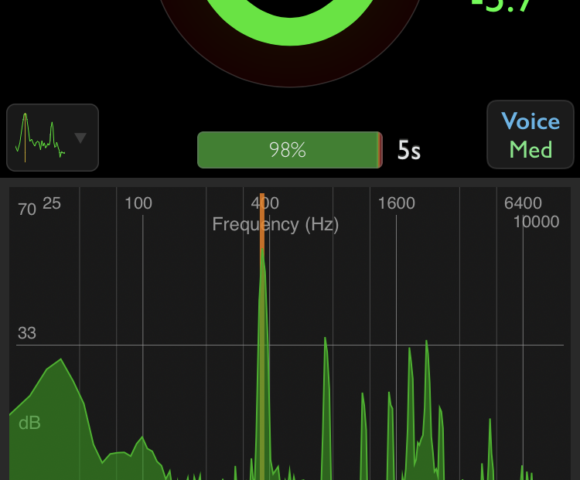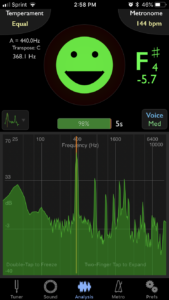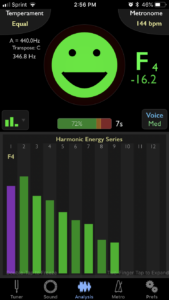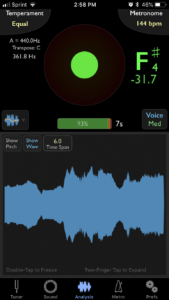Yanny or Laurel?

Do you hear “Yanny” or “Laurel?”
This audio clip was the internet sensation for May 2018. In it, a voice is heard saying a word. Many people hear either “Yanny” or “Laurel,” though at first listen I heard “Yarry.” After a few more listens, I heard “Laurel” but my husband only hears “Yanny” and is rather insistent that it’s impossible to hear anything else. This is especially funny to me because he is a piano techinician with extremely good ears!
In the video below, the audio is changed to highlight the high or low frequencies. Perhaps with a little priming, you can hear both.
A good explanation of the acoustics can be read here on Language Log. (Thanks to James for the link.)
And at this link from the New York Times, you can change the frequencies using a slider to play with this effect yourself.
So what does this have to do with flute playing or singing?
When listening deeply to tone, our ears need to be trained to listen to many different frequencies. During a lesson, I will often close my eyes and listen intently to a student’s tone. I will try to focus on the frequencies.
When I listen to the high frequences, I might hear “hiss” or excess air escaping around the tone hole. The solution to this problem lies in refining the embouchure so that all the air is blowing over the tone hle.
By focusing on the low end of the sound spectrum, I can detect resonance, or lack of it. Students can open the mouth and relax the soft palate to develop the low frequencies in the flute.
In the middle of the spectrum, I am listening for nasal or brassy sounds that might indicate the embouchure is too tight or the tone is focusing too close to the edge of the tone hole.
I use the same sound analysis with the voice, though the problems and solutions are a bit different.
Training the ear to listen to different parts of the auditory spectrum
The “Yanny” vs “Laurel” debate is fun for the water cooler, but I think musicians can learn something from it. When my husband was in school to become a piano technician, they spent a lot of time learning how to hear “beats,” which are the first indicator of intonation. To work on the tone of a piano, he must listen to all parts of the tone, the highs, lows, and middle range of the auditory spectrum. As a teacher, I have to think about this when working with tone and color for flutists and vocalists.
Fortunately, technology allows us easy access to spectrometers. My favorite app for iPhone is TonalEnergy, which gives me several options for specral analysis of tone. I can choose from “Waveform/Pitch,” “Spectral,” and “Harmonic” analyses. Then I can play with mouth shape, air volume, and speed to play with the overtone series. In a previous blog article (Singing In Tune: Intonation Ideas for the Choir) I examined how this technology might be used for vocalists.
The “Yanny vs Laurel” audio is a chance to train the ear
Can you hear both? Or maybe if you listen to other parts of the spectrum, you will hear something in between… or perhaps something entirely different. Is this kind of deep listening helpful for your music practice?
Leave a Reply Cancel reply
You must be logged in to post a comment.
BLOG
- One Grown and Flown September 5, 2023
- Online Music Lessons: One Year And Counting March 25, 2021
- Breathing for Flutists, According to Arnold Jacobs October 31, 2020
- Music Video Projects: Music in the Time of COVID September 30, 2020
- Flutes in Quarantine: Pandemic Safety Part 2 August 31, 2020
- Pandemic Flute Safety, Part 1 July 31, 2020
- Virtual Music: Teaching Lessons Online: The Difficult June 25, 2020
- Virtual Music: Teaching Lessons Online: The Good May 31, 2020
Announcements
FACEBOOK "Like" Miss Marlene- Dance and Sing to get the scoop on preschool music including classes, concerts, and special events. Miss Marlene- Dance and Sing
FLUTE STUDIO
Lesson times are available on Mondays, Tuesday, and Wednesdays. I teach flute and recorder (soprano, alto, tenor, bass) to students of all ages and levels. Prospective students should contact me about a free trial lesson.
Archives
- September 2023
- March 2021
- October 2020
- September 2020
- August 2020
- July 2020
- June 2020
- May 2020
- April 2020
- March 2020
- February 2020
- January 2020
- December 2019
- November 2019
- October 2019
- September 2019
- August 2019
- July 2019
- June 2019
- May 2019
- April 2019
- March 2019
- February 2019
- January 2019
- December 2018
- November 2018
- October 2018
- September 2018
- August 2018
- July 2018
- June 2018
- May 2018
- April 2018
- March 2018
- February 2018
- January 2018
- December 2017
- November 2017
- October 2017
- September 2017
- August 2017
- July 2017
- June 2017
- May 2017
- April 2017
- March 2017
- February 2017
- January 2017
- December 2016
- November 2016
- October 2016
- September 2016
- August 2016
- July 2016
- June 2016
- May 2016
- April 2016
- March 2016
- February 2016
- January 2016
- December 2015
- November 2015
- October 2015
- September 2015
- August 2015
- July 2015
- June 2015
- May 2015
- April 2015
- March 2015
- February 2015



No comments.